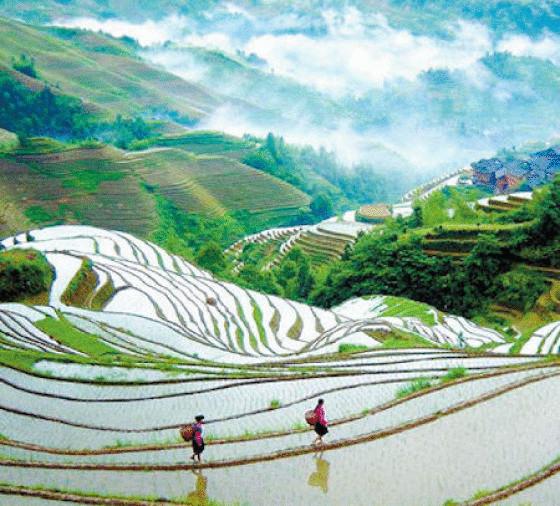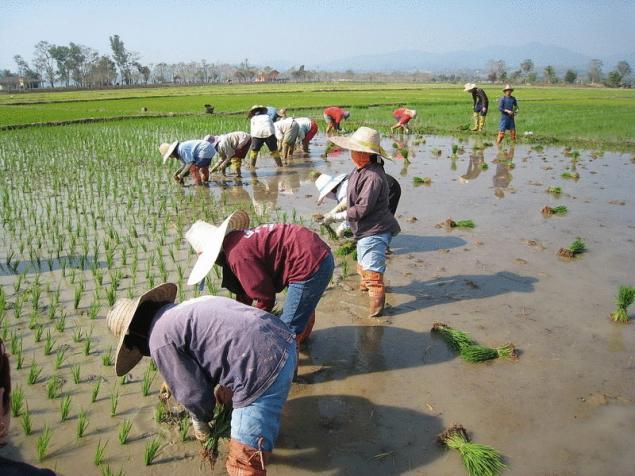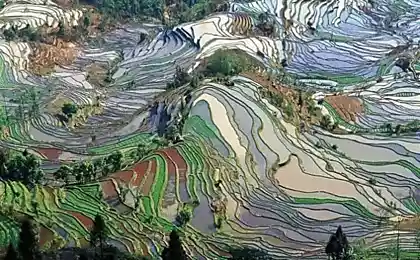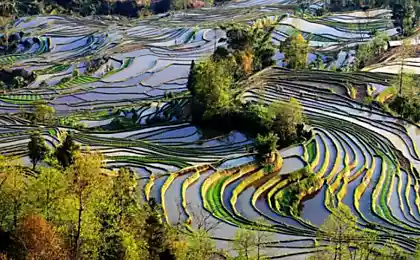771
Chinese "rice theory": as a native speaker form the national mentality
Why is the Gingerbread man chose independence the warmth of family hands? Because it was a wheat. Whether it is rice, the story could have been very different. At least, such a conclusion is from the American-Chinese psychological research.

The East is the conformity and collectivism, Western individualistic values. This paradigm has long become a common place for cross-cultural research. However, recently, an international group of American (universities of Michigan and Virginia) and Chinese (universities of Beijing and Guangzhou) psychologists under the leadership of Thomas Talhelm (mi) published in the journal Science a study demonstrating similar contrast in the East.
Factor responsible for the "Western" or "Oriental" focus countries of Southeast Asia, they consider a dominant in a particular locality crop. Rice, in their opinion, is conducive to collectivism and interdependence, while the wheat – to individualism and rationality.
The study was China, the ideal, according to the authors, the site. On the one hand, it is traditionally cultivated both cultures (the Yangtze river separates the "wheat" from the North "rice" in the South), on the other – the country is much more ethnically and politically homogeneous than Europe or Africa, which reduces the risk of unrecorded differences. To minimize the role of climate, dialect and other regional features in an experimental array was chosen as the population of large cities located in the "rice-wheat border."
The question of what factors are operating in the region, define the mentality of its population, psychologists are set for a long time, so the study still managed to evaluate the correlation between the facts traditional socio-cultural model. The most popular one is the modernization theory, according to which as soon as a society becomes richer, more educated and "capitalistica", its culture is shifting towards intelligence and individualism. However, this model does not explain how it is possible to combine economic prosperity with a traditional holistic and collectivist mentality, countries such as Japan, South Korea and Hong Kong.
The theory is the predominant pathogen is regarded as a culture-forming factor characteristic of a region of infection. In the framework of this model, the more, the more dangerous communication with strangers and the more culture tend to withdraw into ourselves that nourishes teamwork, and reduces openness to new experiences. However, the authors of the American-Chinese study, high risk of infection may be associated with a hot climate, and that, in turn, a factor not previously taken into account — the cultivation of rice.
The theory of rice – is a special case of the theory of method of livelihood, which consists in the fact that some activities by their very nature force people to interact, while other do not require it. In particular, mobile and individualistic shepherds traditionally opposed to stable and community farmers. However, Chinese scholars argue that agricultural mental legacy is more complex.
At the heart of their work – a large-scale quantitative study: 1162 students from major Chinese cities – Beijing, Fujian, Guangdong, Unana, Sichuan and Liaoning – have been proposed a number of tests that measure the type of thinking on the scale of analytical ("no third") / holistic ("each in its own rights"), and on a scale of implicit individualism / group loyalty, teamwork.
To assess the dominant type of thinking was used a classical problem of the "triad": the students were offered three words, like "rails, train, bus", of which we had to choose a couple of "suitable". The choices made on the basis of a conceptual generalization – "train bus" was talking about abstract thinking, and the choice of the "train tracks" on the basis of functional adjacency – about holistic; Western culture generally show in this experiment a shift in the direction of the first, and East Asian – the second type of choice. Similar shifts were found in the responses of students from the "wheat" and "rice" of the regions, respectively.
To assess the degree of individualism the students were supposed to draw sociograms (another classic technique when the subject draws itself, and its network of social and kinship relations in the form of circles connected by lines). According to data accumulated previously, the Americans portrayed in sociogram "themselves" circles by an average of approximately 6 mm larger than the "other" Europeans – 3.5 mm larger, Japanese — a little less, and so on. In China, students of the "rice" of the provinces were willing to portray the "self" is finer than their comrades on average a few hundredths of a millimeter, as in Japan and of wheat – half of a millimeter larger, closer to the European result.
To assess measures of group loyalty (and, in its negative manifestations, predisposition to nepotism, "the zeal of the native little man") used a test that revealed the presence of the participants of double standards: the special relationship of friends compared to strangers is characteristic of collectivist cultures. "Rice culture", as expected, proved to be more prone to double standards than "wheat."
In General, it turned out that China has its own "West" and "East", certainly in the cultural sense of the word, the difference is determined by the nature of the cultivated cereals. To a conventional "Western" models and scenarios located wheat, and to the Oriental — rice regions. But this – in the study base was restricted to one social and age group of students. And will you keep the rice-wheat contrast, if you go beyond it?
To verify this, took another figure traditionally associated with the level of individualism: the divorce rate. In both categories of regions it grew in proportion to the modernization of the Chinese economy, but 50% difference in divorce rates between rice (below) and wheat (above) regions remained.

What distinguishes these agricultural systems so radically? Two parameters: irrigation and nature of the work. Paddy fields need standing water, so the rice regions creates a sophisticated irrigation system is unthinkable without close cooperation between farms, and above all, no water coordination. In addition, to maintain irrigation system in working condition year after year, clean them, drain, refresh – the task was extremely time-consuming and daunting for one person, so it falls on the village as a whole.
Itself rice plantation also involves a lot of work, according to the observations of anthropologists, who visited China before the era of modernization and samarasa the number of hours that the peasants carried out in the fields – two times more than wheat. Medieval Chinese instruction farmer says: if not enough workers, it is better to grow wheat. To rely on our own strength to "rice" culture meant famine.
In such "rice" regions like India, Malaysia and Japan, farmers have traditionally created a sort of labour cooperatives of mutual assistance, to ensure that plantation workers hands at the right time. Family members of these unions coordinated between the time of sowing so that the crop Matures at different times in different farms. This allowed us to draw on the help of those neighbors, whose crops have been harvested already or not yet ripe. The rice was done cooperation economic value, motivated farmers to engage in close social relationships and to avoid conduct that can give rise to conflict.
The wheat, unlike rice, irrigation canals don't need rain to coordinate with the neighbors is also not necessary. Stay sowing of wheat and the harvest, but since they are twice less labor-intensive, respectively, and decreases the need for economy in the help of a neighbor.
Rice theory, the authors argue, can explain the phenomenon of East Asian diversity. Japan and South Korea – enjoy the rice country than can be explained by their strong commitment to collective values, in contrast to the equally rich, but the wheat countries. As for China, it combines both the agrarian culture. If the theory is correct, predict the authors, India, where rice and wheat will develop in Chinese, mixed, way, and Indonesia, with its asiantribune agriculture – Japanese-Korean.
The researchers emphasize that their "rice theory" says about the historically developed mentality of the region, and not about the psychology of the individual, growing rice. None of the informants in the study were not engaged in the cultivation of grain directly, but to be "rice" or "wheat" culture, it is not necessary.
Further, the group intends to study, where rice-wheat is the cultural balance of the population of dry rice fields, does not require such an elaborate irrigation and how and to what extent the "rice culture" is able to replicate itself where there's no rice has long been grown not.
Source: nkj.ru

The East is the conformity and collectivism, Western individualistic values. This paradigm has long become a common place for cross-cultural research. However, recently, an international group of American (universities of Michigan and Virginia) and Chinese (universities of Beijing and Guangzhou) psychologists under the leadership of Thomas Talhelm (mi) published in the journal Science a study demonstrating similar contrast in the East.
Factor responsible for the "Western" or "Oriental" focus countries of Southeast Asia, they consider a dominant in a particular locality crop. Rice, in their opinion, is conducive to collectivism and interdependence, while the wheat – to individualism and rationality.
The study was China, the ideal, according to the authors, the site. On the one hand, it is traditionally cultivated both cultures (the Yangtze river separates the "wheat" from the North "rice" in the South), on the other – the country is much more ethnically and politically homogeneous than Europe or Africa, which reduces the risk of unrecorded differences. To minimize the role of climate, dialect and other regional features in an experimental array was chosen as the population of large cities located in the "rice-wheat border."
The question of what factors are operating in the region, define the mentality of its population, psychologists are set for a long time, so the study still managed to evaluate the correlation between the facts traditional socio-cultural model. The most popular one is the modernization theory, according to which as soon as a society becomes richer, more educated and "capitalistica", its culture is shifting towards intelligence and individualism. However, this model does not explain how it is possible to combine economic prosperity with a traditional holistic and collectivist mentality, countries such as Japan, South Korea and Hong Kong.
The theory is the predominant pathogen is regarded as a culture-forming factor characteristic of a region of infection. In the framework of this model, the more, the more dangerous communication with strangers and the more culture tend to withdraw into ourselves that nourishes teamwork, and reduces openness to new experiences. However, the authors of the American-Chinese study, high risk of infection may be associated with a hot climate, and that, in turn, a factor not previously taken into account — the cultivation of rice.
The theory of rice – is a special case of the theory of method of livelihood, which consists in the fact that some activities by their very nature force people to interact, while other do not require it. In particular, mobile and individualistic shepherds traditionally opposed to stable and community farmers. However, Chinese scholars argue that agricultural mental legacy is more complex.
At the heart of their work – a large-scale quantitative study: 1162 students from major Chinese cities – Beijing, Fujian, Guangdong, Unana, Sichuan and Liaoning – have been proposed a number of tests that measure the type of thinking on the scale of analytical ("no third") / holistic ("each in its own rights"), and on a scale of implicit individualism / group loyalty, teamwork.
To assess the dominant type of thinking was used a classical problem of the "triad": the students were offered three words, like "rails, train, bus", of which we had to choose a couple of "suitable". The choices made on the basis of a conceptual generalization – "train bus" was talking about abstract thinking, and the choice of the "train tracks" on the basis of functional adjacency – about holistic; Western culture generally show in this experiment a shift in the direction of the first, and East Asian – the second type of choice. Similar shifts were found in the responses of students from the "wheat" and "rice" of the regions, respectively.
To assess the degree of individualism the students were supposed to draw sociograms (another classic technique when the subject draws itself, and its network of social and kinship relations in the form of circles connected by lines). According to data accumulated previously, the Americans portrayed in sociogram "themselves" circles by an average of approximately 6 mm larger than the "other" Europeans – 3.5 mm larger, Japanese — a little less, and so on. In China, students of the "rice" of the provinces were willing to portray the "self" is finer than their comrades on average a few hundredths of a millimeter, as in Japan and of wheat – half of a millimeter larger, closer to the European result.
To assess measures of group loyalty (and, in its negative manifestations, predisposition to nepotism, "the zeal of the native little man") used a test that revealed the presence of the participants of double standards: the special relationship of friends compared to strangers is characteristic of collectivist cultures. "Rice culture", as expected, proved to be more prone to double standards than "wheat."
In General, it turned out that China has its own "West" and "East", certainly in the cultural sense of the word, the difference is determined by the nature of the cultivated cereals. To a conventional "Western" models and scenarios located wheat, and to the Oriental — rice regions. But this – in the study base was restricted to one social and age group of students. And will you keep the rice-wheat contrast, if you go beyond it?
To verify this, took another figure traditionally associated with the level of individualism: the divorce rate. In both categories of regions it grew in proportion to the modernization of the Chinese economy, but 50% difference in divorce rates between rice (below) and wheat (above) regions remained.

What distinguishes these agricultural systems so radically? Two parameters: irrigation and nature of the work. Paddy fields need standing water, so the rice regions creates a sophisticated irrigation system is unthinkable without close cooperation between farms, and above all, no water coordination. In addition, to maintain irrigation system in working condition year after year, clean them, drain, refresh – the task was extremely time-consuming and daunting for one person, so it falls on the village as a whole.
Itself rice plantation also involves a lot of work, according to the observations of anthropologists, who visited China before the era of modernization and samarasa the number of hours that the peasants carried out in the fields – two times more than wheat. Medieval Chinese instruction farmer says: if not enough workers, it is better to grow wheat. To rely on our own strength to "rice" culture meant famine.
In such "rice" regions like India, Malaysia and Japan, farmers have traditionally created a sort of labour cooperatives of mutual assistance, to ensure that plantation workers hands at the right time. Family members of these unions coordinated between the time of sowing so that the crop Matures at different times in different farms. This allowed us to draw on the help of those neighbors, whose crops have been harvested already or not yet ripe. The rice was done cooperation economic value, motivated farmers to engage in close social relationships and to avoid conduct that can give rise to conflict.
The wheat, unlike rice, irrigation canals don't need rain to coordinate with the neighbors is also not necessary. Stay sowing of wheat and the harvest, but since they are twice less labor-intensive, respectively, and decreases the need for economy in the help of a neighbor.
Rice theory, the authors argue, can explain the phenomenon of East Asian diversity. Japan and South Korea – enjoy the rice country than can be explained by their strong commitment to collective values, in contrast to the equally rich, but the wheat countries. As for China, it combines both the agrarian culture. If the theory is correct, predict the authors, India, where rice and wheat will develop in Chinese, mixed, way, and Indonesia, with its asiantribune agriculture – Japanese-Korean.
The researchers emphasize that their "rice theory" says about the historically developed mentality of the region, and not about the psychology of the individual, growing rice. None of the informants in the study were not engaged in the cultivation of grain directly, but to be "rice" or "wheat" culture, it is not necessary.
Further, the group intends to study, where rice-wheat is the cultural balance of the population of dry rice fields, does not require such an elaborate irrigation and how and to what extent the "rice culture" is able to replicate itself where there's no rice has long been grown not.
Source: nkj.ru























